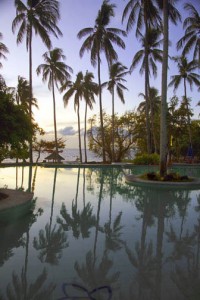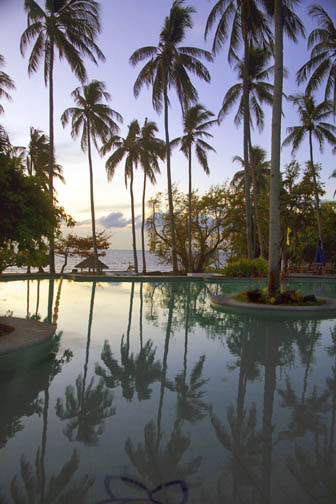
By Denise Mattia
My expectations were great when I embarked on a ten-day trip with a plan to dive a sampling of the innumerable ships sunk during World War II and the coral reefs off islands that comprise the Philippines archipelago. I chose three from the collection of 7,107 islands (some barely break the surface of the water), which divide the South China Sea and the Sulu Sea from the Atlantic Ocean.
You’re in for some great diving in the Philippines,” announced Budd Riker during our interview as guests on the internet show, Let’s Travel Radio. I was delighted to hear this from the renowned photographer and International Director of eBusiness at PADI Worldwide. Political problems, natural disasters and decades of dynamite and cyanide fishing had given the islands a bad rap. In recent years, however, non-governmental conservation organizations such as the Bohol Management Triangle and Coastal Resource Management in addition to high-level government support for environmental practices proved that communities and the government are serious about protecting the coral reefs and the marine environment.
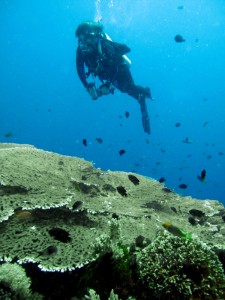 Bound for Bohol Beach
Bound for Bohol Beach
After flights from New York to L.A., then to Manila (with a refueling in Guam), Philippine Airlines connected with a flight south to the city of Tagbilaran in Bohol. Linking up with eight other divers on the tour, we boarded a van bound for the Bohol Beach Club, located a half-hour away on Panglao Island. Situated among manicured grounds, a few yards from the beach, the accommodations here focus on divers’ needs.If I had any qualms about going such a distance just to dive, they disappeared the following morning, when I sank into the waters off Panglao Island.
The reef surrounding the island slopes gradually before dropping off, where it’s thick with giant gorgonian fans – some are big enough to obscure the entire height of a diver. It was a calm day at a site off Balicasag Island, with no current and visibility of about 80 feet. With the help of our guides, Ramon and Jiego, I was able to find more nudibranchs in crevasses and among the human-sized fans than I’d ever seen before. Some of them were black with a mere hint of color, while others were neon blue, orange 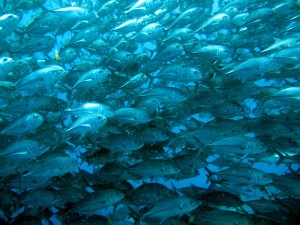 or red. I almost mistook the Notodoris minor for a bright yellow sponge. In the shallows, giant sepia, yellow and white anemones carpet the floor and are accompanied by clown sweetlips, which dart in and out of the anemone’s tentacles. Black-tail barracuda frequently cruise this area, and hawksbill turtles stop here to feed on the substrata. I would have missed a tiny yellow frogfish on our second dive at Recos’ Wall had Ramon not pointed it out. On the other hand, it was hard to miss a massive school of jacks and a bait ball of silversides.
or red. I almost mistook the Notodoris minor for a bright yellow sponge. In the shallows, giant sepia, yellow and white anemones carpet the floor and are accompanied by clown sweetlips, which dart in and out of the anemone’s tentacles. Black-tail barracuda frequently cruise this area, and hawksbill turtles stop here to feed on the substrata. I would have missed a tiny yellow frogfish on our second dive at Recos’ Wall had Ramon not pointed it out. On the other hand, it was hard to miss a massive school of jacks and a bait ball of silversides.
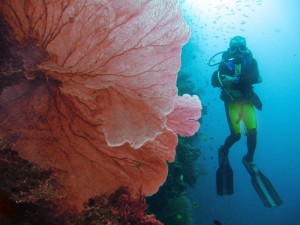 Most dives are done from bancas (outrigger boats), which have been fitted comfortably to accommodate divers. Our group wanted to add a third dive originally but, after having dived to a maximum depth of 65 feet for more than an hour each dive, we rejected the idea out of fatigue.
Most dives are done from bancas (outrigger boats), which have been fitted comfortably to accommodate divers. Our group wanted to add a third dive originally but, after having dived to a maximum depth of 65 feet for more than an hour each dive, we rejected the idea out of fatigue.
Bahura Dive Resort and Apo IslandThe Bohol Beach Club staff ran the operation expertly – they somehow managed to load, change tanks and offload equipment faster and more efficiently than any of us. Reaching shore, I was both grateful and confident with their ability to handle my gear. We were on the move again the next day to visit the famous Tarsier monkeys, the smallest primate in the world, and the Chocolate Hills in Tagbilaran, where we took the Ocean Jet ferry to Dumaguete, on the east cost of Negros Island.
The luxurious Bahura Dive Resort boasts a protected sanctuary house reef. Dive trips reach the renowned Apo Island in just 25 minutes by banca from their shores. Local officials have implemented strict marine sanctuary rules, and the results are visible. Because of unfavorable sea conditions between June and November, Apo Island can be difficult to impossible to reach. The rest of the year guides aren’t sure about currents until they reach the island. We were fortunate. Finning slightly, moorish idols and butterflyfish created wild patterns against the reef when we skimmed down the gradual slope.
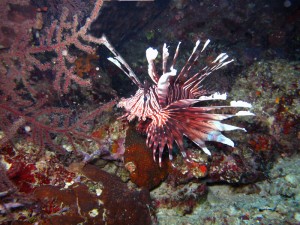 I found several nudibranchs and a minute-sized seahorse in one spot and a ghost pipefish in an overhang. Barrel sponges and black coral fronds, gargantuan and drab in comparison to the tiny, brightly colored nudibranchs, grow at bizarre angles on the shallow wall below. Turtles cruise this island, and we were told to be on the lookout for Napoleon wrasses and blacktip and whitetip sharks. On our way up from the second dive, a sea snake accompanied us to the surface. Extremely poisonous and fatal if bitten, we gave it wide berth. By multi-level diving, I was able to extend my dives to 58 minutes each, with a maximum depth of 113-and 66 feet respectively, eking out very minute of this stunning display of reef fish among hard and soft corals.
I found several nudibranchs and a minute-sized seahorse in one spot and a ghost pipefish in an overhang. Barrel sponges and black coral fronds, gargantuan and drab in comparison to the tiny, brightly colored nudibranchs, grow at bizarre angles on the shallow wall below. Turtles cruise this island, and we were told to be on the lookout for Napoleon wrasses and blacktip and whitetip sharks. On our way up from the second dive, a sea snake accompanied us to the surface. Extremely poisonous and fatal if bitten, we gave it wide berth. By multi-level diving, I was able to extend my dives to 58 minutes each, with a maximum depth of 113-and 66 feet respectively, eking out very minute of this stunning display of reef fish among hard and soft corals.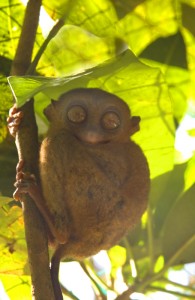
There are Department of Tourism offices in Chicago, Los Angeles, New York and San Francisco. Visit ExperiencePhilippines or WowPhilippines for more information.Note: Pack as lightly as possible. Depending on the domestic carrier’s weight allowance (ten kilos for some), you can be charged heavily for both checked-in and carry-on bags.
About Denise Mattia
A writer and photographer, Denise Mattia’s works are published nationally and internationally and include all aspects of leisure travel: art , culture, resorts, spas, food and wine and sports’ activities. She's the founder of the soon to be launched Yum-Yum-Traveler, a site devoted to reviewing restaurants in addition to her travel articles from around the world. She lives and works in Manhattan, where she was born.
- Web |
- More Posts (91)
